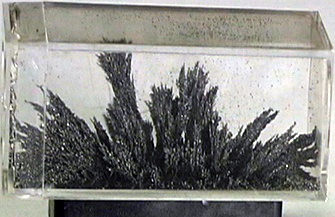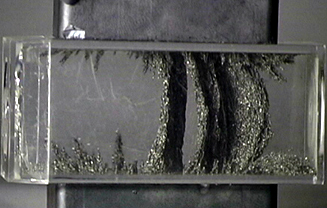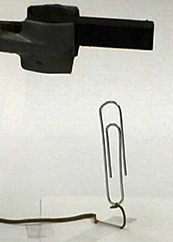|
Magnetism
|
|
|
| Seat Experiment |
|
|
Using a plastic box filled with iron filings, take your magnets and examine their interactions. Recall your earlier experiments with charged tape and straws. |
| Q1: How are the faces of these magnets magnetized? Sketch a magnet, indicating where the field is strongest and weakest, where it changes direction and so forth. The iron filings in the clear box together with the other magnet will help characterize the fields of these magnets. |
|
Use the iron filings in the clear box to examine the field between two magnets. Q2: Draw the observed field between two magnets in two different configurations. |
|
|
|
Assemble the magnetic field test stand as shown, using a paper clip, string or a rubber band and tape. Suspend the clip as shown. Q3: Draw
a free body diagram for the Q4: If the paper clip shown has a mass of 1.45g, what must be the minimum upward magnetic force upon it? |
|
Test the effect of different materials upon the magnetic field by placing a sample within the gap and observing any effects on the clip. Try paper, cloth, plastic, coins, other clips. Q5: Which substances do and do not effect the field and how? |
|
Construct a chain of paper clips as shown. What is the maximum number of clips you can suspend? Q6: How can you use a second magnet to increase this number (sketch this)? Carefully free the topmost clip in your chain from the magnet,
and gradually increase the spacing between the top clip and the
magnet. |
 |
|
Q7: Starting from contact, slowly remove the magnet to a distance of 1 cm. Describe what you observe. Q8: With
a drawing explain this phenomenon in terms of lines of magnetic
field. Q10: How do these fields compare to the electric fields you have studied? |
| References |
| Vecchione, Glen (1995). Magnet Science. NY: Sterling. Feiler, J., & Hooten, N. (1990). Magnets: A World to Discover. Sonoma CA: Dowling Miner Magnetic Corporation. Yahoo!:Science:Physics:Magnetism Master Magnetics (Educational Magnet Supplier) |
|
|
|
|


